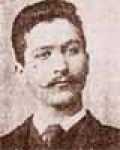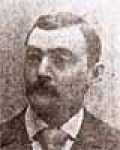McCook cigar factories rolled 40,000 a month

Among the strange habits that Man has adopted is that of smoking tobacco. A few years ago Bob Newhart had a very funny monologue in which he imagined Sir Walter Raleigh trying to introduce tobacco from the New World to his employers in England.
They didn't understand why anyone should want to put a burning leaf into one's mouth. After these many years, and learning of all the negative health effects resulting from smoking, it remains difficult to understand. Yet the smoking of cigars and cigarettes continues to be a very popular habit, worldwide, to the present day.
Smoking was unknown in Europe before 1492. On his return from his first voyage to the New World Columbus and his crew brought back a wild-growing, harsh, variety of tobacco that they had observed the Caribbean natives smoking. When the leaf was introduced in Spain it was used medicinally, in the treatment of disorders such as bubonic plague, migraine headaches, labor pains, asthma, and cancer.

Later, the English colonists at Jamestown exported a much milder tobacco leaf to Europe, which was rolled into cigars, crushed into pipe tobacco, or pulverized into snuff, which was sniffed into the nostrils. Tobacco became very popular throughout Europe, and extremely profitable for the colonists, so much so, that it is said that the English Colonies would have failed had it not been for the tobacco plantations. But tobacco was and is a very labor intensive crop, and the search for workers for the cultivation of tobacco in the southern states certainly played a leading role in bringing African slaves to America.
The smoking of cigarettes was invented in Spain in the 1600s, but cigarettes were hand rolled and expensive and lagged in popularity behind cigars and pipes until late in the 19th Century, when a successful cigarette rolling machine was invented. After that, the price of cigarettes gradually dropped, until by the end of the World War II the smoking of cigarettes was more popular than cigars and pipes combined.
For many years smoking was looked upon as a harmless, if expensive habit. During the Presidential Campaign of 1932, one of the campaign slogans was, "What This Country Needs Is A Good 5 Cent Cigar!"

Smoking in the military was almost universal, especially in wartime. Until the 1970s cigarettes were included in rations for military men, as they were considered to have a soothing effect on the nerves. During the war in Korea in the '50s we were issued two cartons of cigarettes per man per week. American cigarettes were in great demand and were a valuable trading commodity. In the 1960s doctors regularly appeared in TV and print commercials recommending one or another brand of cigarettes.
Of course in the last quarter of a century the link between smoking and a myriad of diseases has been established. The military no longer encourages smoking, and doctors no longer recommend the use of tobacco in any form.
In recent years cigars seem to have made a big comeback. Especially in the east "Cigar Clubs" are very popular -- where well-heeled yuppies, both men and women, can drink and smoke expensive cigars in a friendly, if smoke thick atmosphere, beyond the reach of health minded authorities who would ban such practices.
But in the 1890s cigars were still the preferred choice of smokers. Most towns of any size had at least one cigar manufacturer. Plainview had one and, according to the McCook Columbian Souvenir of 1893, McCook boasted not one, but two cigar factories. J. H. Bennett, Cigar Manufacturer, turned out 20,000 cigars per month. His leading brands were "Little Bijou," "Carmen," and "Silva." Orders were solicited and "Satisfaction was Guaranteed."
At a rival factory, Joseph Reizenstein employed 5 hands in the manufacture of "Fine Havana Cigars." Featured brands were "Havana Trade," "Columbus," and "Grand Union B. of R.T."
Reizenstein's output was also 20,000 cigars per month, but his establishment also featured "Pleasant Rooms, under the Boston Shoe Store, with "Billiard and Pool Tables."
One does not often get a chance to look at life in the 1890s, yet on a recent trip to New Orleans I had a chance to visit a hand-rolled cigar factory, where cigars were being made just as the cigars were made in McCook by Bennett and Reizenstein over 100 years ago.
The cigar makers work in two-man teams, one man blending leaves (minus stems) from several varieties of coarse tobacco, rolling them into cigar shapes, cutting them into correct lengths, putting them into molds, then passing them to his partner who finishes by wrapping the coarse cigar in a very thin, mild, leaf and putting on the smooth tip that the smoker clips prior to smoking. The cigars are then packed in boxes and packs of various sizes. The workers are skilled, fast, and fascinating to watch.
Indeed, the workers are rented out for parties in New Orleans, to make up cigars on the spot for guests to smoke.
Although tobacco seems to grow in a wide range of climates, including as far north as New England, the choice tobaccos used in the manufacture of cigars today, as in the 1890s, seem to come from Central America and the islands of the Caribbean, (the choicest from Cuba). In this particular factory the cigar makers were Cubans who had escaped to this country.
Cuban cigars seem to be highly prized, and difficult to come by in the United States, since there is an embargo on Cuban products in this country. In Mexico Cuban cigars are readily available, highly advertised, and (to my mind) expensive, ie: $18.50 for the Cuban Torpedo. (Could Bennett and Reizenstein ever have believed that price for a cigar?)
On the cruise ships that land at various ports in Mexico there is a special room on board where passengers can bring their Cuban cigars to smoke, and is very popular. But frequently announcements are heard on board that since it is illegal to bring Cuban cigars into the United States, All must be smoked prior to landing in the United States, or left on board.
The embargo is especially frustrating to the many Canadians who cruise the Caribbean, as it is perfectly legal for Canadians to possess Cuban products. The catch is that since the ship docks in the United States, they cannot bring their cigars onto U.S. soil on their way to Canada. Naturally, not everyone agrees with this policy, and someone is always trying to circumvent the law.
We heard of a certain Canadian, on a recent voyage, who decided that he could make his fortune selling Cuban ci--gars in the United States. After all, no one would search a Canadian citizen coming into the United States (he thought). He made a very large purchase of hundreds of Cuban cigars, left most of his clothes aboard, and filled his suitcases with cigars, then headed off the ship.
Disembarkation normally goes very smoothly and quickly, with the customs officials making only cursory inspections. But they apparently have a policy of thoroughly searching the baggage of one of every so many passengers. As luck would have it, the Canadian happened to be the one they chose on that trip. Not only, were his cigars confiscated, the authorities greatly extended his vacation, and he paid a year's wages in fines. Somehow, I feel that that is one fellow who will never smoke another Cuban cigar.
